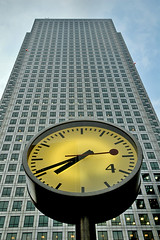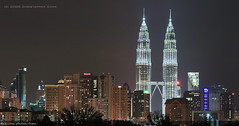
I must confess to having a slightly geeky fascination with tall buildings – particularly the unusual and iconic ones. Growing up in London during the 1970’s and 1980’s, I remember thinking of skyscrapers as an exclusively North American phenomenon, epitomised of course by the Manhattan skyline – the iconic Empire State Building, The Chrysler Building and of course the ill-fated World Trade Center. My travels at that point had been exclusively European, so these images were confined to the television and the cinema. And all European cities – including London, appeared distinctly low rise in comparison.
The Far East and the Manhattan Skyline

In my twenties, I spent 3 years living and working in Kuala Lumpur, Malaysia, where the Petronas Twin Towers were under construction, and the skyscraper mantle appeared to be passing from the USA to the Far East – symbolising the rapid expansion of these Tiger economies. For a short while the Petronas Twin Towers were the tallest on the planet, but I was struck by the not only by the sheer scale of these buildings, but also the dramatic and imposing architecture. Since then I’ve also visited New York, and was lucky enough to get to the top of not only the Empire State Building but also the World Trade Center – a little over a year before 9-11.
Returning from Malaysia in the late 90’s I was reminded how distinctly low rise London had remained over the years. Tower 42 (183m) in the City and One Canada Square (235m) in Canary Wharf were the city’s only genuine skyscrapers. However, since then, visitors to London cannot have failed to notice the dramatic changes to the city’s skyline over the past decade.
The London Skyscraper Boom

In the last 10 years London has witnessed an unprecedented spate of high rise development. London currently has nine buildings under construction that will be over 100 metres (328 ft) tall upon completion. Of the nine, Renzo Piano’s Shard (London Bridge) is the tallest at 310m (1,017 ft). The next tallest is the Pinnacle which – at 288m – will dominate the skyscraper cluster in the City of London.
Indeed the Shard, not due to be complete until May 2012 is already the the tallest building in the UK (it surpassed One Canada Square’s 235m in November 2010) and when finished, it will be the tallest building in the European Union – somewhat unbelievably incredibly using more steel than the entire Olympic site! The Shard will boast premium office space, the Shangri-La hotel, luxury apartments, a shopping mall, restaurants, a spa – and at the top of the building a 15 story public viewing gallery.
However with the with the completion of the Shard and the other 8 skyscrapers, this period of high rise construction in London appears to be drawing to a close, as recession bites and priorities change.
It seems an appropriate time to briefly chart the history of the London Skyscraper – why did the city remain resolutely low rise for so long, followed by a decade of unprecedented high rise construction. And why has it so abruptly come to a halt?
The London Building Act 1894
Until 1962, St Paul’s Cathedral(111m) had been London’s tallest building for over 250 years. That year it was supplanted by the Post Office Tower (now the BT Tower). It’s worth saying that since 1894, legislation had restricted building heights in the city. The London Building Act prohibited buildings over 80ft high, and became law as a direct result of Queen Anne’s Mansions, a block of flats in Westminster over 100ft tall, which prompted many complaints – including Queen Victoria herself, who objected to the new building blocking her view of Parliament from Buckingham Palace.
Although these restrictions have long since been relaxed, the culture of low rise had become embedded in 20th Century London construction. Regulations remain in place to preserve “protected views” – St Paul’s Cathedral, the Tower of London, and the Palace of Westminster, to name but three. Additionally, compliance with the Civil Aviation Authority – many of the main commercial flight paths pass directly over London – as well as healthy opposition to high-rise from the conservation group English Heritage has meant that the low rise culture remained dominant throughout the late 20th Century.
London’s First Genuine Skyscrapers

Despite this, the height restrictions were lifted during the 1960’s, which led to a small number notable high rise buildings – albeit over a 30 year period. The Post Office Tower in was followed 18 years later by the NatWest Tower (now Tower 42) in 1980, which at 183m was London’s first genuine skyscraper. And the Canary Wharf development which heralded the redevelopment of Docklands in the 1980’s led in 1991 to the completion of the 235m One Canada Square (designed by César Pelli, who also went on to design Kuala Lumpur’s Petronas Twin Towers)
The Impact of Terrorism
I would speculate that the threat of terrorism held back the development of more skyscrapers in London during this period. The revolving restaurant at the top of the Post Office Tower was bombed in 1971 by the IRA, and was closed to the public in 1980. (Recent attempts to re-open the restaurant have stalled, allegedly because it had become impossible to insure). The Bishopsgate Estate in the City was bombed by the IRA in 1993, causing £1 billion of damage to the NatWest Tower (Tower 42). So it would perhaps be understandable if planning excluded extensive skyscraper development because of concerns over potential terrorist attacks.
Into the 21st Century

Having said that, the boom in London skyscraper development has occurred in the post 9-11 era. Significant new additions appeared in two main areas – Canary Wharf and Bishopsgate in the City. Many of these these buildings have had innovative designs and – eschewing the conservatism of previous decades – have added some unusual shapes and new character to London’s skyline. Many of these have subsequently been given affectionate nicknames – notably the Gherkin (or more properly 30, St Mary Axe). Under contruction we have the Cheese Grater (122 Leadenhall Street), the Walkie Talkie (20 Fenchurch Street) as well as the aforementioned Pinnacle or Helter Skelter (Bishopsgate Tower)
So why did this skyscraper boom occur. I think the simple answer is: it mirrors the economic boom of the early 21st Century. The UK was experiencing a longer period of economic growth, than at any time over the previous 100 years. London was becoming the world’s pre-eminent financial centre, and needed buildings to reflect its new image. Skyscrapers have long been associated with the financial services industry, and of course as a demonstration of wealth. High rise towers appeal particularly to companies who want to make a statement.
It also helped to have a sympathetic mayor. Ken Livingston was an active supported of skyscraper construction in London. His critics said he was in thrall to property developers and was allowing London’s skyline to be disfigured by tall buildings. Livingston response was characteristically robust: :If you want to build a tall building, as long as you’ve got a world-class design and it is in one of two locations we will go along with it”
The London Skyline – disfigured or enhanced?
The Shard is the exception to this rule of course, being the only skyscraper south of the river – in Southwark. In my personal opinion, these additions to the skyline have – by and large – enhanced it rather than disfigured it. I like the unplanned, organic nature of London’s development. Back in 1666, following the Great Fire of London, Sir Christopher Wren had grand plans to impose a grid system on the capital, to bring order from chaos, but before he could act on his plans landowners rebuilt on existing plots and the maintained the essentially medieval layout ever since for large parts of the city. I like that. And I like the juxtaposition of old historic buildings and new 21st century icons. the fact that London remains in perpetual redevelopment demonstrates that the city is alive. It’s not a museum.
And let’s not forget that internationally speaking, London is still comparatively low-rise. The skyscrapers are confined to 3 small areas of the capital. The Shard may be the tallest building in the UK, but it’s only the 45th tallest in the world! Compared to the Burj Khalifa (828m) in Dubai, the Shard is a midget!
The Future of the London Skyscraper
So what of the future? Tammy Newell has written a blog post about the future of high rise development In London – particularly office space. However suffice to say that as with the economic boom, the skyscraper building boom is also well and truly over. Skyscrapers’ association with the financial sector no longer serves them well, given the tarnished reputation of the banks. More importantly, the economics of building a skyscrapers are very different from low-rise buildings. With traditional construction, large projects can be built in stages – developers can use rental income from Phase One to help pay for Phase Two and so on and so forth. Skyscrapers cannot earn rental income until they are completed. Additionally, skyscrapers are 50% more expensive than similar sized low-rise offices, because of the more complicated engineering required to construct them.
This is just one piece of the puzzle. We’re constantly answering the most important office search questions. See what else we’ve covered and what’s coming next.
Related Posts

Calculate how much office space you need in 4 steps
Unsure about how to calculate how much office space you need? If you follow the rules, it’s easy to calculate the correct size requirements.
Read MoreFor more essential tips and advice, have a look at The Knowledge - and for answers to your questions about London office space, check out our FAQs.
Ben has been designing, building and promoting websites for over 20 years. He is responsible for all of Find a London Office’s online activity, which broadly falls into 2 areas: gaining new clients and retaining existing ones.
